
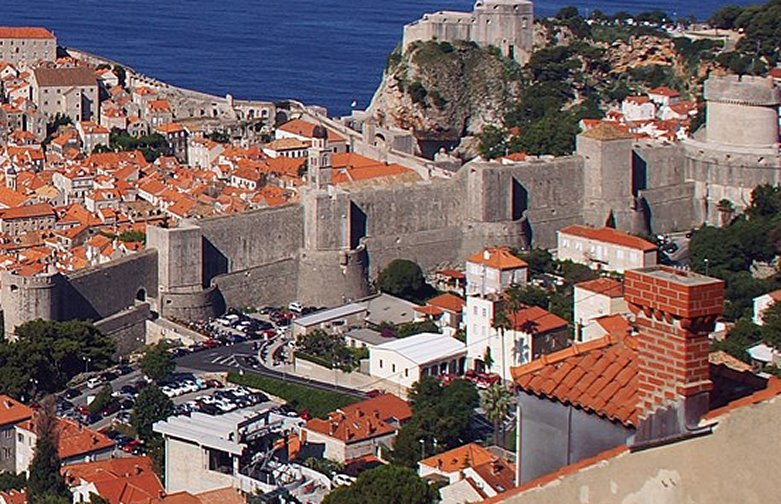
DUBROVNIKIn 1991, after the break-up of Yugoslavia, Dubrovnik was besieged by Serbian and Montenegrin soldiers of the Yugoslav People's Army (JNA) for seven months and suffered significant damage from shelling. After repair and restoration works in the 1990s and early 2000s, Dubrovnik re-emerged as one of the top tourist destinations in the Mediterranean.The names Dubrovnik and Ragusa co-existed for several centuries. Ragusa, recorded in various forms since at least the 10th century, remained the official name of the Republic of Ragusa until 1808, and of the city within the Kingdom of Dalmatia until 1918, while Dubrovnik, first recorded in the late 12th century, was in widespread use by the late 16th or early 17th century. The name Dubrovnik of the Adriatic city is first recorded in the Charter of Ban Kulin (1189). It is mostly explained as dubron, a Celtic name for water (Gaulish dubron, Irish dobar, Welsh dŵr, dwfr, Cornish dofer), akin to the toponyms Douvres, Dover, and Tauber; or originating from a Proto-Slavic word dǫbъ meaning 'oak'. The term dubrovnik means the 'oakwood', as in all other Slavic languages the word dub, dàb, means 'oak' and dubrava, dąbrowa means the 'oakwood'. The historical name Ragusa is recorded in the Greek form Ῥαούσιν (Rhaousin, Latinized Ragusium) in the 10th century. It was recorded in various forms in the medieval period, Rausia, Lavusa, Labusa, Raugia, Rachusa. Various attempts have been made to etymologize the name. Suggestions include derivation from Greek ῥάξ, ῥαγός "grape"; from Greek ῥώξ, ῥωγός "narrow passage"; Greek ῥωγάς "ragged (of rocks)", ῥαγή (ῥαγάς) "fissure"; from the name of the Epirote tribe of the Rhogoi, from an unidentified Illyrian substrate. A connection to the name of Sicilian Ragusa has also been proposed. Putanec (1993) gives a review of etymological suggestion, and favours an explanation of the name as pre-Greek ("Pelasgian"), from a root cognate to Greek ῥαγή "fissure", with a suffix -ussa also found in the Greek name of Brač, Elaphousa. The classical explanation of the name is due to Constantine VII's De Administrando Imperio (10th century). According to this account, Ragusa (Ῥαούσιν) is the foundation of the refugees from Epidaurum (Ragusa Vecchia), a Greek city situated some 15 km to the south of Ragusa, when that city was destroyed in the Slavic incursions of the 7th century. The name is explained as a corruption of Lausa, the name of the rocky island on which the city was built (connected by Constantine to Greek λᾶας "rock, stone"). |
 |
 |
City wall
According to Constantine Porphyrogenitus's De Administrando Imperio (c. 950), Ragusa was founded in the 7th century, named after a "rocky island" called Lausa, by refugees from Epidaurum (Ragusa Vecchia), a Greek city situated some 15 km to the south, when that city was destroyed in the Slavic incursions.Excavations in 2007 revealed a Byzantine basilica from the 8th century and parts of the city walls. The size of the old basilica clearly indicates that there was quite a large settlement at the time. There is also evidence for the presence of a settlement in the pre-Christian era. Antun Ničetić, in his 1996 book Povijest dubrovačke luke ("History of the Port of Dubrovnik"), expounds the theory that Dubrovnik was established by Greek sailors, as a station halfway between the two Greek settlements of Budva and Korčula, 95 nautical miles (176 km) apart from each other. After the fall of the Ostrogothic Kingdom, the town came under the protection of the Byzantine Empire. Dubrovnik in those medieval centuries had a Roman population. In 12th and 13th centuries Dubrovnik became a truly oligarchic republic, and benefited greatly by becoming a commercial outpost for the rising and prosperous Serbian state, especially after the signing of a treaty with Stefan the First-Crowned. After the Crusades, Dubrovnik came under the sovereignty of Venice (1205–1358), which would give its institutions to the Dalmatian city. In 1240, Ragusa purchased the island of Lastovo from Stefan Uroš I king of Serbia who had rights over the island as ruler of parts of Hum. After a fire destroyed most of the city in the night of August 16, 1296, a new urban plan was developed. By the Peace Treaty of Zadar in 1358, Dubrovnik achieved relative independence as a vassal-state of the Kingdom of Hungary. Ragusa experienced further expansion when, in 1333, Serbian emperor Stefan Dušan, sold Pelješac and Ston in exchange for cash and an annual tribute at the moment when her connection with the rest of Europe, especially Italy, brought her into the full current of the Western Renaissance. Between the 14th century and 1808, Dubrovnik ruled itself as a free state, although it was a tributary from 1382 to 1804 of the Ottoman Empire and paid an annual tribute to its sultan. The Republic reached its peak in the 15th and 16th centuries, when its thalassocracy rivalled that of the Republic of Venice and other Italian maritime republics. For centuries, Dubrovnik was an ally of Ancona, the other Adriatic maritime republic rival of Venice, which was itself the Ottoman Empire's chief rival for control of the Adriatic. This alliance enabled the two towns set on opposite sides of the Adriatic to resist attempts by the Venetians to make the Adriatic a "Venetian Bay", also controlling directly or indirectly all the Adriatic ports. Ancona and Dubrovnik developed an alternative trade route to the Venetian (Venice-Austria-Germany): starting in Dubrovnik it went on to Ancona, through Florence and ended in Flanders as seen on this map. |
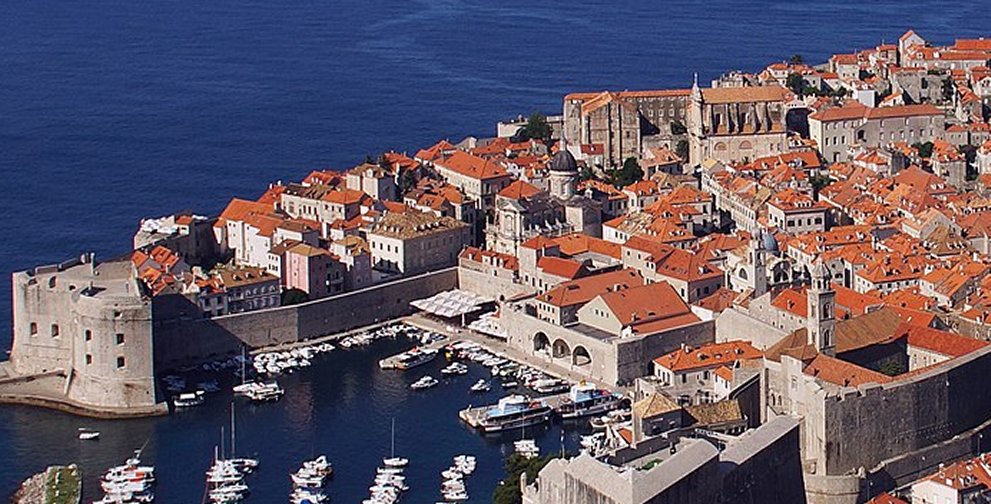 |
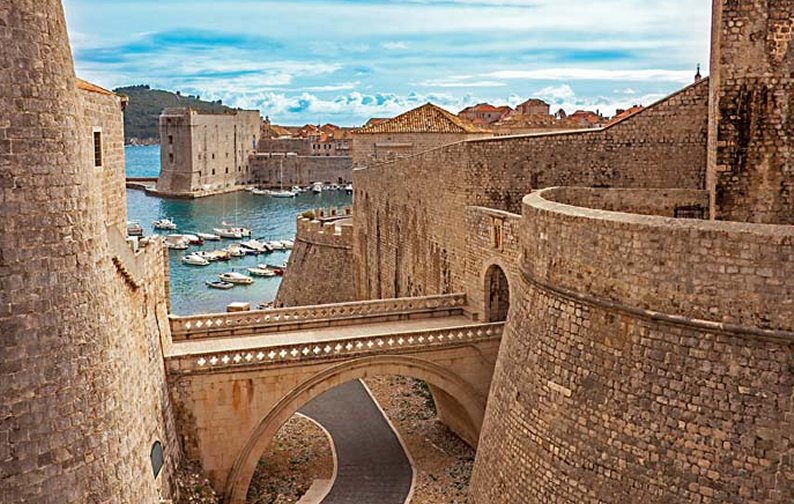 |
The Republic of Ragusa received its own Statutes as early as 1272, which, among other things, codified Roman practice and local customs. The Statutes included prescriptions for town planning and the regulation of quarantine (for sanitary reasons).The Republic was an early adopter of what are now regarded as modern laws and institutions: a medical service was introduced in 1301, with the first pharmacy, still operating to this day, being opened in 1317. An almshouse was opened in 1347, and the first quarantine hospital (Lazarete) was established in 1377. Slave trading was abolished in 1418, and an orphanage opened in 1432. A 20 km water supply system, instead of a cistern, was constructed in 1438 by the Neapolitan architect and engineer Onofrio della Cava. He completed the aqueduct with two public fountains. He also built a number of mills along one of its branches. The city was ruled by the local aristocracy which was of Latin-Dalmatian extraction and formed two city councils. As usual for the time, they maintained a strict system of social classes. The republic abolished the slave trade early in the 15th century and valued liberty highly. The city successfully balanced its sovereignty between the interests of Venice and the Ottoman Empire for centuries. The languages spoken by the people were the Romance Dalmatian and common Croatian. The latter started to replace Dalmatian little by little from the 11th century among the common inhabitants of the city. Italian and Venetian would become important languages of culture and trade in Dubrovnik. At the same time, Dubrovnik became a cradle of Croatian literature. The economic wealth of the Republic was partially the result of the land it developed, but especially of seafaring trade. With the help of skilled diplomacy, Dubrovnik merchants travelled lands freely and the city had a huge fleet of merchant ships (argosy) that travelled all over the world. From these travels they founded some settlements, from India to America, and brought parts of their culture and flora home with them. One of its keys to success was not conquering, but trading and sailing under a white flag with the Latin: Libertas word (freedom) prominently featured on it. The flag was adopted when slave trading was abolished in 1418. Many Conversos, Jews from Spain and Portugal, were attracted to the city. In May 1544, a ship landed there filled exclusively with Portuguese refugees, as Balthasar de Faria reported to King John. During this time there worked in the city one of the most famous cannon and bell founders of his time: Ivan Rabljanin (Magister Johannes Baptista Arbensis de la Tolle). Already in 1571 Dubrovnik sold its protectorate over some Christian settlements in other parts of the Ottoman Empire to France and Venice. At that time there was also a colony of Dubrovnik in Fes in Morocco. The bishop of Dubrovnik was a Cardinal protector in 1571. At that time there were only 16 other countries which had Cardinal protectors; those being France, Spain, Austria, Portugal, Poland, England, Scotland, Ireland, Naples, Sicily, Sardinia, Savoy, Lucca, Greece, Illyria, Armenia and Lebanon. The Republic gradually declined due to a combination of a Mediterranean shipping crisis and the catastrophic earthquake of 1667 which killed over 5,000 citizens, levelled most of the public buildings and, consequently, negatively impacted the whole well-being of the Republic. In 1699, the Republic was forced to sell two mainland patches of its territory to the Ottomans in order to avoid being caught in the clash with advancing Venetian forces. Today this strip of land belongs to Bosnia and Herzegovina and is that country's only direct access to the Adriatic. A highlight of Dubrovnik's diplomacy was the involvement in the American Revolution. |
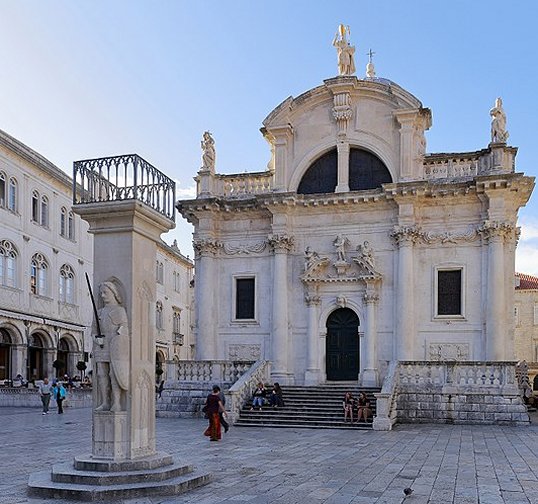 |
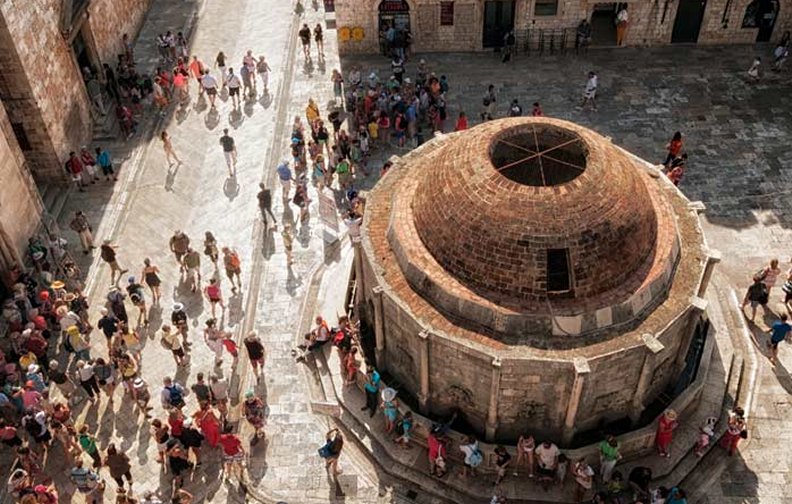 |
Saint Blasius (Sveti Vlaho) from 1715 The main promenade Stradun with the Onofrio fountain from 1438
On 27 May 1806, the forces of the Empire of France occupied the neutral Republic of Ragusa. Upon entering Ragusan territory without permission and approaching the capital, the French General Jacques Lauriston demanded that his troops be allowed to rest and be provided with food and drink in the city before continuing on to take possession of their holdings in the Bay of Kotor. However, this was a deception because as soon as they entered the city, they proceeded to occupy it in the name of Napoleon. Almost immediately after the beginning of the French occupation, Russian and Montenegrin troops entered Ragusan territory and began fighting the French army, raiding and pillaging everything along the way and culminating in a siege of the occupied city (during which 3,000 cannonballs fell on the city). In 1808 Marshal Marmont issued a proclamation abolishing the Republic of Ragusa and amalgamating its territory into the French Empire's client state, the Napoleonic Kingdom of Italy. Marmont claimed the newly created title of "Duke of Ragusa" (Duc de Raguse) and in 1810 Ragusa, together with Istria and Dalmatia, went to the newly created French Illyrian Provinces.After seven years of French occupation, encouraged by the desertion of French soldiers after the failed invasion of Russia and the reentry of Austria in the war, all the social classes of the Ragusan people rose up in a general insurrection, led by the patricians, against the Napoleonic invaders. On 18 June 1813, together with British forces they forced the surrender of the French garrison of the island of Šipan, soon also the heavily fortified town of Ston and the island of Lopud, after which the insurrection spread throughout the mainland, starting with Konavle. They then laid siege to the occupied city, helped by the British Royal Navy, who had enjoyed unopposed domination over the Adriatic sea, under the command of Captain William Hoste, with his ships HMS Bacchante and HMS Saracen. Soon the population inside the city joined the insurrection. The Austrian Empire sent a force under General Todor Milutinović offering to help their Ragusan allies. However, as was soon shown, their intention was to in fact replace the French occupation of Ragusa with their own. Seducing one of the temporary governors of the Republic, Biagio Bernardo Caboga, with promises of power and influence (which were later cut short and who died in ignominy, branded as a traitor by his people), they managed to convince him to keep the gate to the east closed to the Ragusan forces and to let Austrian forces enter the City from the west, once the French garrison of 500 troops under General Joseph de Montrichard had surrendered. After this, the Flag of Saint Blaise was flown alongside the Austrian and British colors, but only for two days because, on 30 January, General Milutinović ordered Mayor Sabo Giorgi to lower it. Overwhelmed by a feeling of deep patriotic pride, Giorgi, the last Rector of the Republic, refused to do so "for the masses had hoisted it". Subsequent events proved that Austria took every possible opportunity to invade the entire coast of the eastern Adriatic, from Venice to Kotor. The Austrians did everything in their power to eliminate the Ragusa issue at the Congress of Vienna. Ragusan representative Miho Bona, elected at the last meeting of the Major Council, was denied participation in the Congress, while Milutinović, prior to the final agreement of the allies, assumed complete control of the city. Regardless of the fact that the government of the Ragusan Republic never signed any capitulation nor relinquished its sovereignty, which according to the rules of Klemens von Metternich that Austria adopted for the Vienna Congress should have meant that the Republic would be restored, the Austrian Empire managed to convince the other allies to allow it to keep the territory of the Republic. While many smaller and less significant cities and former countries were permitted an audience, that right was refused to the representative of the Ragusan Republic. All of this was in blatant contradiction to the solemn treaties that the Austrian Emperors signed with the Republic: the first on 20 August 1684, in which Leopold I promises and guarantees inviolate liberty ("inviolatam libertatem") to the Republic, and the second in 1772, in which the Empress Maria Theresa promises protection and respect of the inviolability of the freedom and territory of the Republic.
Languages The Italian language as spoken in the republic was heavily influenced by the Venetian language and the Tuscan dialect. Italian took root among the Dalmatian-speaking merchant upper classes, as a result of Venetian influence which strengthened the original Latin element of the population.
Austrian rule The combination of these two forces—a flawed Habsburg administrative system and new national movement claiming ethnicity as the founding block toward a community—posed a particularly perplexing problem: Dalmatia was a province ruled by the German-speaking Habsburg monarchy, with bilingual (Serbo-Croatian- and Italian-speaking) elites that dominated the general population consisting of a Slavic Catholic majority, as well as a Slavic Orthodox minority. Further complicating matters was the reality that increased emphases on ethnic identification in the nineteenth century did not break down along religious lines, as evident in the Serb-Catholic movement in Dubrovnik. In 1815, the former Dubrovnik Government (its noble assembly) met for the last time in Ljetnikovac in Mokošica. Once again, extreme measures were taken to re-establish the Republic, but it was all in vain. After the fall of the Republic most of the aristocracy was recognised by the Austrian Empire. In 1832, Baron Šišmundo Getaldić-Gundulić (Sigismondo Ghetaldi-Gondola) (1795–1860) was elected Mayor of Dubrovnik, serving for 13 years; the Austrian government granted him the title of "Baron". Count Rafael Pucić (Raffaele Pozza), (1828–1890) was elected for first time Podestà of Dubrovnik in the year 1869 after this was re-elected in 1872, 1875, 1882, 1884) and elected twice into the Dalmatian Council, 1870, 1876. The victory of the Nationalists in Split in 1882 strongly affected in the areas of Korčula and Dubrovnik. It was greeted by the mayor (podestà) of Dubrovnik Rafael Pucić, the National Reading Club of Dubrovnik, the Workers Association of Dubrovnik and the review "Slovinac"; by the communities of Kuna and Orebić, the latter one getting the nationalist government even before Split. In 1889, the Serb-Catholics circle supported Baron Francesco Ghetaldi-Gondola, the candidate of the Autonomous Party, vs the candidate of Popular Party Vlaho de Giulli, in the 1890 election to the Dalmatian Diet. The following year, during the local government election, the Autonomous Party won the municipal re-election with Francesco Gondola, who died in power in 1899. The alliance won the election again on 27 May 1894. Frano Getaldić-Gundulić founded the Società Philately on 4 December 1890. In 1905, the Committee for establishing electric tram service, headed by Luko Bunić – certainly one of the most deserving persons who contributed to the realisation of the project – was established. Other members of the Committee were Ivo Papi, Miho Papi, Artur Saraka, Mato Šarić, Antun Pugliesi, Mato Gracić, Ivo Degiulli, Ernest Katić and Antun Milić.The tram service in Dubrovnik existed from 1910 to 1970. Pero Čingrija (1837–1921), one of the leaders of the People's Party in Dalmatia, played the main role in the merger of the People's Party and the Party of Right into a single Croatian Party in 1905. |
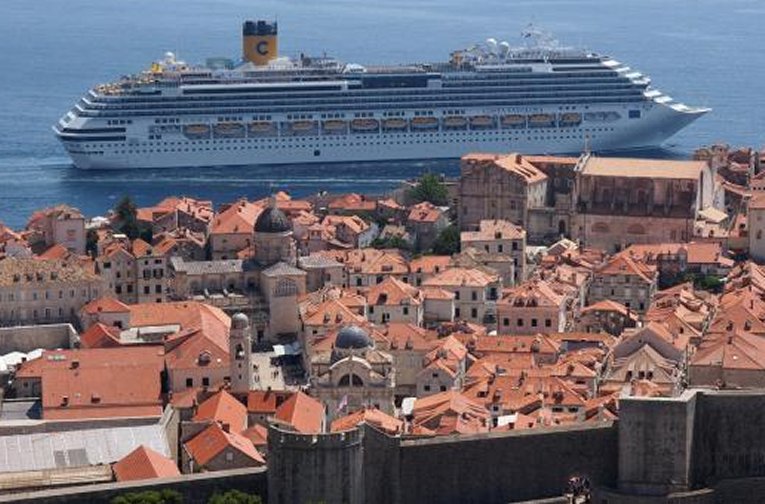 |
 |
Too many cruise liners Cable car to the local mountain Brdo Srd
1918–1991With the fall of Austria–Hungary in 1918, the city was incorporated into the new Kingdom of Serbs, Croats, and Slovenes (later the Kingdom of Yugoslavia). Dubrovnik became one of the 33 oblasts of the Kingdom. When in 1929 Yugoslavia was divided among 9 Banovina, the city became part of the Zeta Banovina. In 1939 Dubrovnik became part of the newly created Banovina of Croatia. During World War II, Dubrovnik became part of the Nazi-puppet Independent State of Croatia, occupied by the Italian army first, and by the German army after 8 September 1943. In October 1944 Yugoslav Partisans occupied Dubrovnik, arresting more than 300 citizens and executing 53 without trial; this event came to be known, after the small island on which it occurred, as the Daksa Massacre. Communist leadership during the next several years continued political prosecutions, which culminated on 12 April 1947 with the capture and imprisonment of more than 90 citizens of Dubrovnik. Under communism Dubrovnik became part of the Socialist Republic of Croatia and Socialist Federal Republic of Yugoslavia. In 1979, the city joined the UNESCO list of World Heritage Sites.
Since 1991: Breakup of Yugoslavia and its aftermath Despite demilitarisation of the old town in early 1970s in an attempt to prevent it from ever becoming a casualty of war, following Croatia's independence in 1991 Yugoslavia's Yugoslav People's Army (JNA), by then composed primarily of Serbs, attacked the city. The new Croatian government set up military outpost in the city itself. Montenegro, led by president Momir Bulatović, and prime minister Milo Đukanović, coming to power in the Anti-bureaucratic revolution and allied to Slobodan Milošević in Serbia, declared that Dubrovnik should not remain in Croatia because they claimed it historically had never been part of an independent Croatia, but rather more historically aligned with the coastal history of Montenegro.[citation needed] Be that as it may, at the time most residents of Dubrovnik had come to identify as Croatian, with self-identified Serbs accounting for 6.8 percent of the population. On October 1, 1991 Dubrovnik was attacked by JNA with a siege of Dubrovnik that lasted for seven months. The heaviest artillery attack was on December 6 with 19 people killed and 60 wounded. The number of casualties in the conflict, according to Croatian Red Cross, was 114 killed civilians, among them poet Milan Milišić. Foreign newspapers were criticised for placing heavier attention on the damage suffered by the old town than on human casualties. Nonetheless, the artillery attacks on Dubrovnik damaged 56% of its buildings to some degree, as the historic walled city, a UNESCO world heritage site, sustained 650 hits by artillery rounds. The Croatian Army lifted the siege in May 1992, and liberated Dubrovnik's surroundings by the end of October, but the danger of sudden attacks by the JNA lasted for another three years. Following the end of the war, damage caused by the shelling of the Old Town was repaired. Adhering to UNESCO guidelines, repairs were performed in the original style. Most of the reconstruction work was done between 1995 and 1999. The inflicted damage can be seen on a chart near the city gate, showing all artillery hits during the siege, and is clearly visible from high points around the city in the form of the more brightly coloured new roofs. ICTY indictments were issued for JNA generals and officers involved in the bombing. General Pavle Strugar, who coordinated the attack on the city, was sentenced to a seven-and-a-half-year prison term by the International Criminal Tribunal for the former Yugoslavia for his role in the attack. The 1996 Croatia USAF CT-43 crash, near Dubrovnik Airport, killed everyone on a United States Air Force jet with United States Secretary of Commerce Ron Brown, The New York Times Frankfurt Bureau chief Nathaniel C. Nash and 33 other people. |
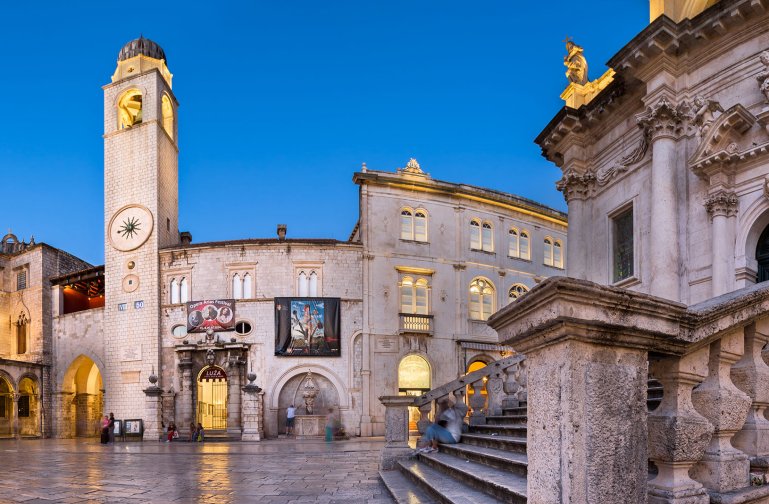 |
 |
The Luža bell tower Cathedral of the Assumption of the Virgin Mary
SightsDubrovnik is considered one of the most beautiful cities in the Mediterranean and is a centre of tourism. The city is becoming a meeting place for the international jet set and high society. The old town is car-free except for limited delivery and resident traffic; in the vicinity of the old town, the parking space available is very limited.
• The city walls of Dubrovnik are 1940 meters long and up to three to six meters wide and completely passable. They are the best preserved fortification system in Europe and comprise a perfectly preserved complex of public and private, sacral and secular buildings from all periods of the city's history, starting with its foundation in the 7th century. |
 |
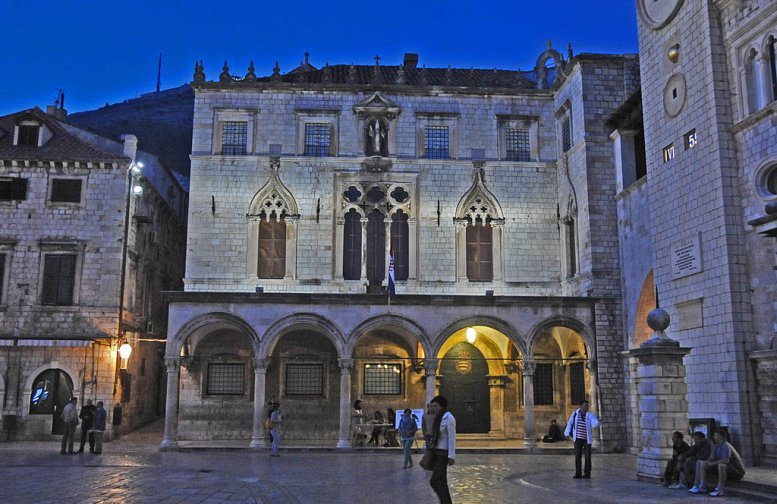 |
View to the Stradun Rectors Palace
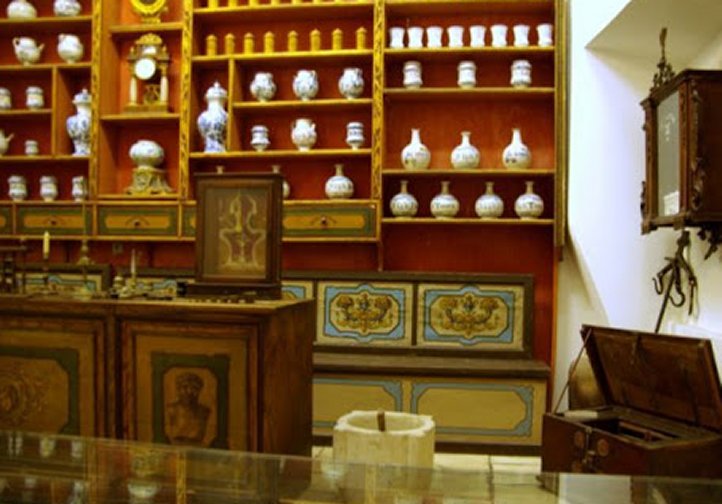 |
 |
Pharmacy from 1317 Franciscan monastery
Further sightsare the Roland Column, the customs house, the Sponza Palace and the bell tower. Furthermore, Dubrovnik has one of the oldest municipal theatres in Europe, where performances are still taking place. On the offshore island of Lokrum and in the suburb of Ploče there are military hospitals, here called Lazareti, where for the first time in Europe in 1377, travellers arriving in the city had to stay in quarantine for 30 days, later 40 days in isolation, to prevent theBlack Death. The world's oldest arboretum, Arboretum Trsteno, which was established around 1492, is located near the city of Dubrovnik. The Lovrijenac fortress is situated west of the old town on a 37-metre-high rock. The inscription on the fortress "Non bene pro toto libertas venditur auro" means in English "Freedom is not sold for all the gold in the world". It was first mentioned in an official document in 1301. The island of Lokrum was first mentioned in 1023 as the site of an abbey and a Benedictine monastery. In 1839 the Archduke Maximilian of Austria bought the island and built a summer house. The plants in the garden come mainly from Australia and South America. In 1963 the island was declared a nature reserve and in 1976 it was declared a special forest reserve. The lake Mrtvo More (Dead Sea) is directly connected with the open sea.
|